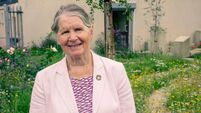Archives: There are few things more difficult to get than a good cup of coffee

During the First World War, the Cork Refreshment Committee provided travelling sailors and soldiers with free tea, coffee, and buns at what is now Kent Station. Picture: Irish Examiner Archive
We often ask for it, but how often do we get it, that we are not sorry we did not "stick to tea,“ as we say?
It is strange, but true, that there are few things more difficult to get either in private houses or in restaurants than a good cup of coffee, so stimulating, so refreshing!
It cannot he denied that coffee as a diet drink, in spite of its fine qualities, has never been as popular in the British Isles as it ought to be. That may be attributed very largely to the difficulty in getting well-made coffee. It is so old a drink that it is entitled to much better treatment from cooks and the like than it generally receives.
Coffee is the product chiefly of coffea arabica, a plant indigenous to Abyssinia, which, however, as cultivated originally spread outwards from the southern parts of Arabia. The name is thought to be derived from the Arabic. "K'hawah"; by some it is traced to Caffa, a province of Abyssinia, which is a much more likely explanation.
The early history of coffee as an economic product is somewhat obscure; but what is lacking in historical fact is certainly compensated for by an unusual abundance of conjectural statements and mythical stories.
HISTORY HUB
If you are interested in this article then no doubt you will enjoy exploring the various history collections and content in our history hub. Check it out HERE and happy reading
According to an Arabic account the use of coffee was introduced into Aden from the African coast by a sheikh about 1470: but, according to another account, the use of coffee as a beverage was prevalent among the Abyssinians from the most remote period, and when first introduced in Arabia it only supplanted a preparation from the leaves of another plant.
The Mahomedans took to it at once as a drink that would help to keep them awake at their prolonged religious services, during which they sometimes became so weary that they fell fast asleep.
But the use of coffee as a devotional anti-soporific stirred up fierce opposition on the part of the more strictly orthodox Mahometan priests. They tried to make out, unsuccessfully, that coffee was an intoxicating beverage, and therefore prohibited by the Koran; it was pointed out contra that the word used in the Koran referred only to wine.
And in spite of opposition the habit of coffee-drinking spread rapidly among the Arabian Mahometans, and the growing of coffee, as well as the using of it as a national beverage, became as completely associated with Arabia as tea is with China.
For about two centuries the entire coffee supply of the world, which, however, was then limited, was obtained from the province of Yemen in South Arabia, where the celebrated mocha or mokha is still cultivated.
But the knowledge of and taste for coffee spread very slowly outwards from Arabia, and it was not until the middle of the 16th century that coffeehouses were established in Constantinople.

Here there was also bitter opposition, because they interfered with the attendance at the mosques, many Turks preferring to go to the coffee house than to the mosque, just as the modern Britisher often prefers to go to his club than to church.
The opposition of the religious party was so fiercely hostile that the Sultan, at the instance of the priests, imposed a heavy tax on coffee houses; but still they flourished.
Meanwhile, the growing of the coffee plant progressed, surely, if slowly. It is worthy of note that down to 1600 the only source of coffee supply was Arabia, but it happened that in that year Governor General Van Hoorne of the Dutch East Indies received a few coffee seeds from traders, who plied between the Arabian Gulf and Java.
These he planted in his garden at Batavia, whom they grew and flourished so abundantly that their cultivation on an extended scale was immediately commenced in Java.
One of the first plants grown on that island was sent to Holland as a present to the Governor (or director) of the Dutch East India Company. It was planted in the botanic gardens at Amsterdam, and young plants grown from its seed were sent to Surinam, where the cultivation was established in 1718.
Ten years later the plant was introduced into the West Indian Islands, and gradually the culture extended throughout the New World, till now the progressing of the single plant sent from Java to Holland produces more coffee than is grown by all the other plants in the world. The culture of the coffee plant is now general throughout all civilized regions of the tropical world. In point of quantity exported, Brazil leads the list of coffee-growing countries.
In course of time coffee came to England as an article of use. It appears that a Mr. Daniel Edwards, an English merchant, of Smyrna, brought with him to London a Greek named Pasqua Rossi in 1652, who made coffee for his employer.
This Mr. Edwards married one Ald. Hodges's daughter, who lived in Wallbrook , and set up Pasqua Rossi as a coffee-man in a shed in the churchyard of St. Michael's, Cornhill, when he soon did such a trade that the ale-sellers got alarmed and petitioned the Lord Mayor against him as being no freeman.
Alderman Hodges, who appears to have been running the show, then joined his coachman, Bowman, who was free, as Pasqua Rossi’s partner.
Rossi erected a sign (with his portrait) over the shop, announcing himself to be "the first who made and sold coffee drink in England".
A little later, Rossi had for some naughtiness or other to fly the country, and Bowman by his good trade and his resources, and "a contribution of 1,000 sixpences" turned the shed into a house: The house was late on rebuilt by Bowman after the Great Fire of 1666 and still later became part of the well-known Jamaica Coffee House.
The coffee trade in England did not progress without opposition. The coffee houses met with the same bitter opposition in England as elsewhere, and in 1675 Charles II endeavoured to suppress them by a Royal proclamation in which it was stated the coffee houses were the resort of disaffected persons "who devised and spread abroad devious and malicious reports to his Majesty’s Government and to the disturbance or the peace, and quiet of the nation.''
The law officers of the Crown being consulted as to the legality of this step it was stated by them “that the retailing of coffee might be an innocent trade, but as it was used in nourish sedition, spread lies and scandalise great men it might also be a common nuisance — a very indefinite conclusion.
The history of Garroway’s famous coffee house where the best markets, the brightest wits might he found, of Carlisle's Almanacs and others is a long history and a most interesting one.
Coffee is spoken of as being in use in France between 1640 and 1650, and thereafter, it may be said, the use of coffee was an established thing in Europe.
In France, coffee was better received than in England and they know better how to use it. Yet even in France it was treated at first and a passing craze.
True, the fashion of liking Racine has to an extent passed away, but the fashion of coffee, instead of passing away, has become the most confirmed custom and habit of the French nation. And the French use coffee more than the English , because they have always known so much better how to use it; that makes all the difference.
It is noteworthy that the principal popular beverages were introduced into Britain within a few years of each other. Cocoa was the first that appeared in Europe, having been like the potatoes brought to Spain from South America, coffee following from Arabia, while tea, the last, was brought by the Dutch from China.
Some years ago it used to be almost impossible, even in the best hotels, to get an even tolerably good cup of coffee, but with the advent of certain appliances to help the cook, coffee is far better now than ever before but everyone is not so fortunate as to have a coffee machine, and there is the difficulty.
I have often been asked, what is the best way to make coffee? There are several ways, some quite simple.
A great point about coffee-making is to have it, if possible, fresh ground, and for this purpose a small coffee mill will be necessary. These mills are quite inexpensive, may often be bought second-hand for a few shillings, and last for many years.
If you grind your own coffee, select a light brown berry rather than a very dark one, because the latter are often dark from being over-roasted, and will give a bitter taste to the coffee.
The best way to make coffee is in a percolator, either of tin or porcelain. If you use a porcelain percolator you will need to put the coffee in muslin bag, or put a piece of muslin on the percolator so as to keep back the grains. In the case of a tin percolator that will not be necessary. But whatever you make the coffee in use enough coffee.
The real trouble with English coffee is that those who make it will not enough coffee. Use good coffee and allow a tablespoonful and a half for each breakfast cup of coffee.
When the coffee is made in the percolator it must be kept from boiling again, for that would spoil it. When the coffee is made in the percolator it must be kept from boiling again for that would spoil it.
When the coffee is made in the percolator it must be kept from boiling again, for that would spoil it. When the coffee is made put it on a hot plate or somewhere else on the stove keep it quite hot because there is nothing more objectionable than lukewarm coffee.
Here is a ready way of making good coffee: Thoroughly warm an ordinary stout porcelain or earthen jug, put the required quantity of coffee into it, pour on the boiling water, leave it rest for a minute, then stir it briskly for a few minutes to separate the grains, let it rest on the stove for a few minutes, and then throw into the jug, from a little height, about a wineglassful of cold water. That causes the grains to settle, and in another two minutes you can pour off the coffee into the jug or coffeepot from which it is to be served, keeping back the sediment; add the same quantity of very hot milk, and you have café au lait of the best kind.
The French people, whether they use a percolator or not, always use equal quantities of hot coffee and hot milk.
After dinner café noir must be strong and clear as sherry, and served black with chartreuse or anything else of the same kind, with a jug of cream for those who may like to have cream.
The composts I have been offered for coffee, and that, too, in first-class hotels, where the chefs might be supposed to know the first principles of coffee-making, would make the angels weep!
And to young things about to be married and to launch their barque on the sea of troubles comprised in that one word “housekeeping”, I should like to say:
I have even known husbands and wives not to speak to each other for a whole week and serious mother-in-law complications to arise through a bad, weak cup of coffee.
I pray you avoid it.
- First published in the , May 25, 1923.













